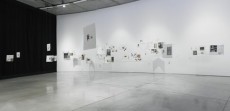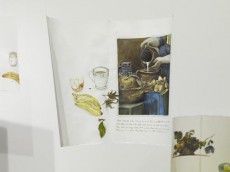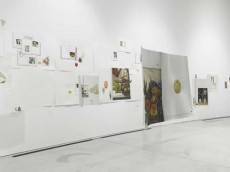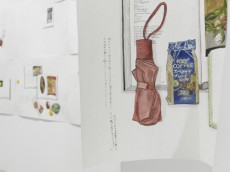
kaetemiru–Time For A Change
10:00am-6:00pm, October 22 — December 11, 2016/ admission free
Renata CRUZ
レナータ・クルス
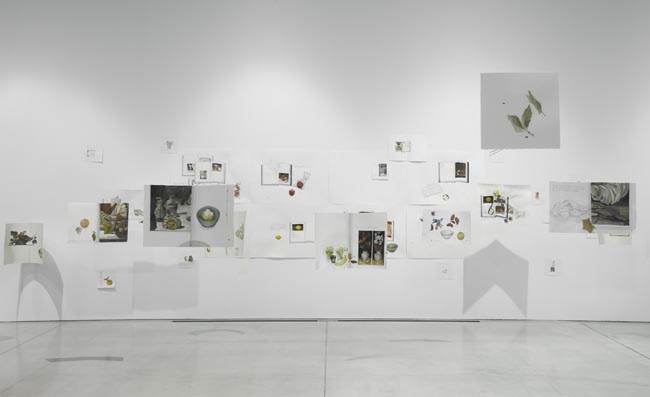
"Forever and a day"
water color on paper, 2016.
photo: YAMAMOTO Tadasu
Painting as an Open Book
KONDO Yuki
Renata CRUZ works with images from everyday life—apples, flowers, fallen leaves, and tea cups—together with passages of text from paperbacks and paintings from art books. They are rendered and replicated as watercolors, carefully drawn on different-sized paper. The everyday items, drawn in the same dimensions as the immaculately replicated pages of the open art books on which she places them, mix within her paintings to create two juxtaposed motifs—that of the art books, and that of the everyday items. In the margins are accompanying sentences about time, taken from works such as DAZAI Osamu’s Tsugaru and Jorge Luis BORGES’ Ficciones and A History of Eternity. As the title of her work forever and a day indicates, the axes of past, present, and future intertwine within the ample margins—sentences that speak of past and future are separated from their context and juxtaposed with motifs based on daily life that seem to be of the here and now as well as on numerous recreations of traditional European allegorical still lifes.
These works are exhibited as an installation, with large paper drawings of open art books hung at random on the main gallery wall. Stepping back from the wall, we see countless watercolor paintings and fragments of text floating in the air, as if they had spilled out of the pages of the open art books on the wall. The large margins in each of the paintings share an affinity with the wall surface and serve as a bridge between the physical space and the painting space, gently connecting the three-dimensional space outside the work with the two-dimensional space within.
Cruz mainly draws with watercolors on paper, then develops her works into installations that mix physical space and virtual imagery. Text is frequently appended to her work, with books—as both material and symbolic entities—referenced in content as well as form. Her work is characterized by drawings that appear realistic yet uniformly lack mass, not seeking the detail of superrealism. In Lemon, the object emerges with paper-thin presence within the painting’s wide margins and is accompanied by a piece of literary text. Rather than a faithful reproduction of the object’s physical properties, Cruz uses watercolors to cast a confrontational layer of time against the object, seemingly drawing only the outer surface in order to transfer its non-material figure as a virtual image.
Cruz drew several works for Time For A Change using the exchange system that she has developed over several exhibitions in different countries. Cruz has participants bring something of sentimental value, which she draws meticulously in reproductions similar to the illustrations you might find in an encyclopedia. More important than the object itself is the story behind it, and Cruz spends time listening to each person’s narrative, which often becomes passages of text in the margins of these artworks that hint at the stories behind the objects. Though accurate and sometimes encyclopedic portrayals, her artworks go beyond their original shapes to conjure up an inner spiritual relationship between the objects and their owners.
Cruz often lends her drawings literary passages, but will also use her own words on occasion, writing them as if they were penned by someone else. Neither directly related nor completely unrelated to the images they adorn, the interpretation of the text and its relationship to the image is left open to unfold in any direction. What links the two—the object and the text—is the imagination of the viewer, who must try to fill in the gaps in a fragmented context to create their own narrative. By creating jumpable gaps between her still lifes of familiar, personal objects and passages quoted from literature, she gracefully transforms the story of both the artist and the supplier of the object into a more open-ended, universal narrative. Thus, even as physical, personal consumables, Cruz’s objects come to possess symbolic, even universal properties on a single sheet of paper. They express a fleeting moment in time, yet they are also eternal. In forever and a day, she allows us to read symbolic meaning in the daily objects that frequent her work. Her work makes an even stronger impression when we realize that it is reminiscent of 16–17th-century European still life paintings that combine aspects of transience and eternity.
The ambiguous connotation of her artworks is superimposed with books, which Cruz often references in her work. Cruz is sympathetic with the ambiguity of books, paper, and beauty—though physically fragile and easily destroyed, their contents and spirit possess an indestructible strength.[1] They may be written in trivial letters on humble pages of paper, but books connote a resilient, tenacious knowledge and spirit. Similarly, through her work we can find beauty and knowledge in the everyday things around us. Seen in this light, it is as if the contents of a book have spilled out to form her installation, which we can interpret as a recreation of the reading experience. Just as the act of reading belongs to a personal time and experience, so does the act of art appreciation. But the transformation of reading into a work of art opens it up to the world.Within the space outside her drawings, Cruz attempts to reconstruct the proximity that reading brings between the spiritual world and everyday life.
[1] Renata CRUZ, personal communication, November 16, 2016. (AC2, no. 18. Aomori Contemporary Art Centre, 2017.)
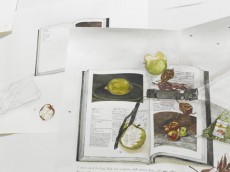
fig.1
"Forever and a day"
water color on paper
installation,2016.
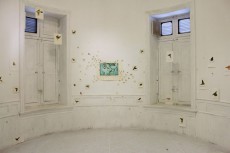
fig.2
"Área de soltura"
water color on paper
installation, 2015.
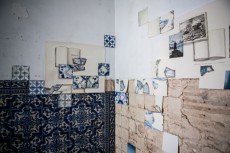
fig.3
"Instabilidade no palácio"
water color on paper
installation, 2014.

fig.4
"Um desenho por dia"
water color on paper
365 drawings of symbolic objects
changed with people,2012.
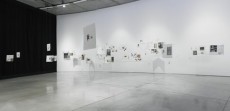


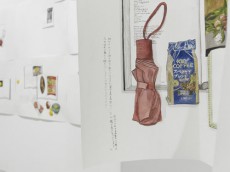
カエテミル
2016年10月22日(土)~12月11日(日)10:00~18:00 会期中無休・入場無料
レナータ・クルス
Renata CRUZ
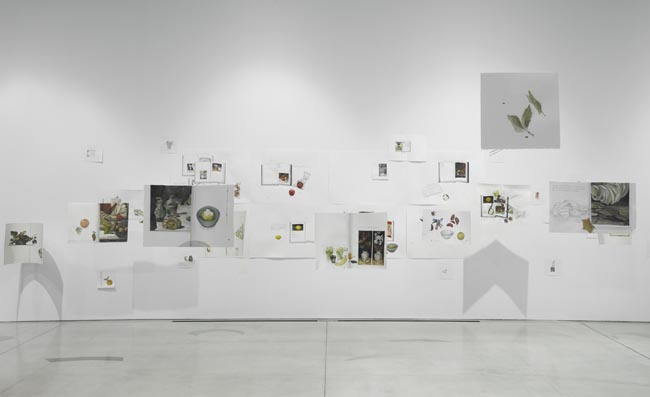
《永遠と一日》
紙に水彩、2016年
撮影:山本糾
開かれた本としての絵画
近藤由紀
大小様々の大きさの紙には、リンゴや花、落ち葉や茶わんといった身の回りの品々、ペーパーバックや画集といった本類、そしてそれら本類から描き抜かれた文章の一節や絵画の模写などが水彩絵の具で丹念に描かれている。解説の細かい文字まで写された画集のページは開かれ、その上に置かれた身の回りの品々は、同じ静物画内のモチーフとして同じ次元で描かれ、画集の模写として描かれた絵の中のモチーフと、日用品として描かれたモチーフが並置されることで二つの次元が画面の中で混在している。[fig.1]画面の余白には、太宰治の『津軽』やボルヘスの『伝奇集』と『永遠の歴史』から引用された時間に関する文章が添えられている。過去や未来の時を語る文脈から切り離された文章と、今、ここにあるように見える生活に密着したモチーフ、そして数々のヨーロッパ伝統の寓意的な静物画の模写の並置は、《永遠と一日》という作品タイトルが示す通り、過去、現在、未来の時間軸を交錯させ、余白は豊かな行間を生み出している。
これらの作品はインスタレーションとして展示される。広いギャラリーの壁面にランダムに貼られた大きな紙には、ページが開かれたままに置かれた画集が多く描かれている。その壁面から反対側の壁に向って空間内には無数の水彩画が宙に浮いているように吊り下げられ、描かれた絵と文字の断片は、あたかも壁面の画集の開いたページから想像的な空間に溢れ出てきているかのように展示されている。一枚一枚の絵画の内に大きく取られた余白は、壁面や物理的空間との親和性が高く、現実空間と絵画空間をつなぐ橋渡しとなり、作品内外の三次元的空間と二次元的空間を緩やかにつないでいる。
レナータ・クルスの作品は主に紙に水彩によって描かれ、それらは物理的な空間と仮象的なイメージを混成させながらインスタレーションとして展開されていく。[fig.2][fig.3]図像にはしばしば文章が添えられ、物質的、象徴的存在としての「本」が作品の内容と形式に参照されている。現実の事物を丹念に描き写したような写実的な描画が特徴的だが、描かれた事物は一様に量感に乏しく、写真と見紛うようなスーパーリアリズムは求められていない。余白の多い画面に薄い存在感で浮き立つように描かれ、文学から引用された文章が添えられた「レモン」は、物理的性質を忠実に再現しようとして描かれたというよりは、作者が対象と対峙した時間を水彩絵の具でなぞり、その仮象像としての非物質的な姿を紙に移し取っているようにみえる。
今回クルスはこれまでも様々な国で継続的に行っている交換式作品制作プロジェクトをACACでも行い、作品の一部にこの交換によって描かれた作品も加えられている。[fig.4]このプロジェクトでクルスは、鑑賞者に思い出深い品を持ち寄ってもらい、それらを図鑑の挿絵のように忠実に描くのだが、重要なのはその品々にまつわるエピソードをクルスが聞き、ある時間を参加者と過ごすことにある。ここで描かれた作品もそれぞれの余白にしばしば文章が書き添えられる。余白や行間はそれらの事物の背後の物語をにおわせ、作品が展示として標本的に羅列されたとしても、それぞれの物としての形以上に、物と持ち主との内的で精神的な関係を想起させる。
クルスの作品に添えられる文章の多くは文学から取り入れられる。加えて自身が作った文章が、あたかも他の作者が書いたように書かれることもある。それらは描かれたイメージと無関係ではないが、それほど近い関係にあるわけでもなく、いくつかの方向に開かれた関係性を保っている。それを結びつけるのは、目の前の分断された文脈を埋めようとする見る者の想像力とそれぞれの物語の創出による。クルスは、身近で個人的な事物を描いた静物画と文学から引用された文章の間にこうした飛び越えられるくらいの断絶を作ることで、作者あるいは物品提供者の個人的な物語を見る者に開かれた普遍的な物語へと軽やかに転換させていく。こうして物理的、個別的な消耗品としての事物は、象徴的、普遍的な事物として性質を一枚の紙の上で併せ持つことで、刹那と永遠を獲得する。《永遠と一日》と題された今回の作品では、モチーフとして用いられた日常的な事物から象徴的な意味を読み取らせ、刹那の世界で永遠の相を描き出した16-17世紀ヨーロッパの静物画のイメージがその印象をより強くさせた。
こうした作品における両義性は、クルスが参照する「本」とも重ねられる。クルスは「本」、「紙」そして「美」について、物理的には脆弱で容易く破壊することができるこれらが、同時に内容や精神において破壊不可能な強度を持つその両義性に共感を抱いている[1]。紙に書かれた文字という取るに足らない素材で作られた本は、強く、失われることのない知や精神を内包している。同じように我々は身の回りのあらゆるものから作品を通じて、美や知を見出すことができる。そう捉えると、本の中身が空間に溢れ出るように展開されたインスタレーションは、読書体験の再現とみることもできる。読書体験が個人的な時間と体験に属するように、作品の鑑賞体験もまた個人的な時間と体験に属する。だがそれは作品として変換されることで外の世界に開かれる。読書体験が引き起こすような日常生活と精神世界の近接が、絵の外側である空間の内に再構築することが試みられている。
[1] 2016年11月16日に行ったレナータ・クルスへのインタビューより(『AC2』no.18、国際芸術センター青森、2017年)。
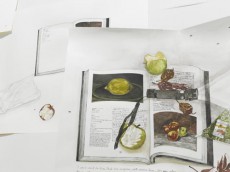
fig.1《永遠と一日》
紙に水彩(インスタレーション)、2016年
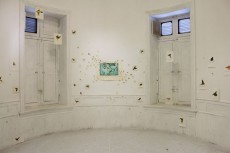
fig.2《Área de soltura》
紙に水彩(インスタレーション)、2015年

fig.3《Instabilidade no palácio》
紙に水彩(インスタレーション)、2014年

fig.4《Um desenho por dia,》
紙に水彩、人々と交換した
象徴的なオブジェのドローイング365枚、
2012年
